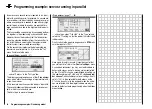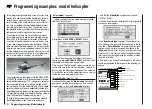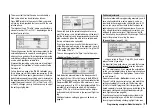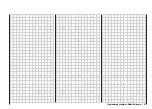
106
unless you know exactly what you are doing. Start by
setting the collective pitch stick to centre. Assuming that
you previously adjusted the servos in accordance with
the manufacturer’s instructions, the servo output arms
will now (usually) be at right-angles to the servo case. If
you have not already done so, adjust the mechanical lin-
kages to the rotor head so that all the blades are set to a
collective pitch angle of 4° to 5° positive for the hover. All
known helicopters will fl y at this approximate setting.
Now push the collective pitch stick fully forward to the
maximum collective pitch point. (The solid vertical line
indicates the current position of the stick.) Adjust Point 5
on the collective pitch curve using the right-hand rocker
button, with the aim of producing a maximum collective
pitch setting of around 9° at the main rotor blades. This
point should be at a value of around 50%.
Note:
A rotor blade set-up gauge, e.g. the GRAUPNER item,
Order No.
61
, is very useful when setting up blade pitch
angles, as you can read off the angles directly.
Now pull the collective pitch stick right back to the coll-
ective pitch minimum position. Set the blade pitch ang-
le for Point 1 to 0 to -4°, depending on your piloting abili-
ty. This produces a slightly angled line at the hover point,
forming what is known as the collective pitch curve. It
might look approximately like this:
If you now switch to the autorotation phase – you will
see the name of the fl ight phase “Autorot” at the bottom
of the screen – the “old” collective pitch curve will re-ap-
“off”.
If you wish, you could at this point move to the line abo-
ve and assign a fl ight phase switch for fl ight phase 2, but
this simple programming example deliberately excludes
such refi nements.
You have now completed the basic settings at the trans-
mitter, i.e. the procedure which you will need to use time
and again when setting up new models.
The actual helicopter-specifi c set-up is carried out pri-
marily in the menu ...
»Heli mixers«
(page 66 ... 73)
In the very fi rst line you will see the “
Collective pitch
”
function, and pressing
ENTER
or
SELECT
takes you to
the appropriate sub-menu. At this point you will see a
graphic representation of the collective pitch curve. This
is initially defi ned by only three reference points, but in
most cases this is quite adequate.
Tip:
Always try to manage with these three reference points
initially, as additional points just complicate the matter,
and extra complexity is just what you don’t need at the
moment.
The reference point for hovering should generally be the
mechanical centre-point of the collective pitch stick, as
this position feels completely natural to most pilots. You
can, of course, set up the curve to locate the hover at a
different point, but you should not be tempted to do this
pear. In this phase you should set the same values as in
the normal phase, with the following exception: increa-
se the pitch angle at Point 5 (collective pitch maximum)
by about 2°. This gives slightly more pitch for fl aring the
model when practising “autos” at a later (!) date.
Once you have set up the collective pitch curve, press
ESC
to return to the helicopter mixer menu select point.
Now we move on to the “
Ch1
throttle
” line, where
you can set up the throttle curve.
The fi rst step here is to enter the idle trim range by ad-
justing the throttle curve. Move the collective pitch stick
to the minimum position, and set Point 1 to a value of
around -65%.
With the throttle limiter closed and the idle trim fully
open, pull the collective pitch stick to the “fully back” po-
sition and move it slightly to and fro. The throttle servo
should not respond to this movement. This arrangement
gives you a seamless transition from idle trim to the
throttle curve. You will probably need to make further ad-
justments to the throttle curve, but this must be carried
out later as part of the fl ight-testing process.
If you now switch temporarily from this graph to the au-
torotation fl ight phase, you will see – instead of the usu-
al display – the following:
Programming examples: Model helicopter
Summary of Contents for MX-16S
Page 1: ...1...
Page 17: ...17...
Page 31: ...31 Fixed wing models Installation and connections...
Page 35: ...35 Program description Reserving a new memory...
Page 47: ...47 Base settings Model helicopter...
Page 83: ...83 Fail safe...
Page 89: ...89 Programming examples Fixed wing model...
Page 109: ...109 Programming examples Model helicopter...
Page 112: ...112 112...
Page 116: ...116...

























